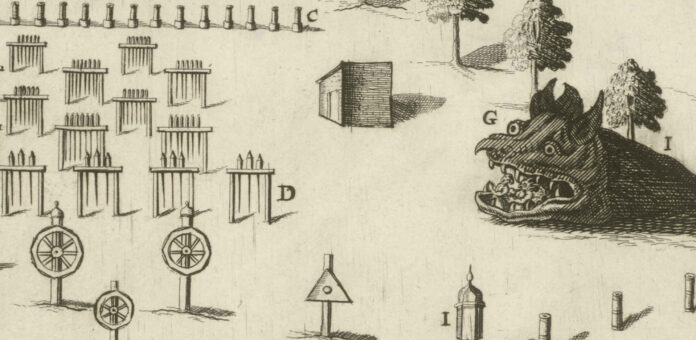Fireworks are a momentary, ephemeral art form that leave nothing behind except for fond memories and a great deal of waste. For centuries, they have been the most materially intensive and expensive art form in existence; today we are aware that the waste and negative environmental impact involved in generating this brief moment of beauty and spectacle are simply not sustainable. But what do we know about the evolution of fireworks, their historical and cultural strongholds, their medial and political significance? And what does the future hold for this art form? In the exhibition Cracked Up and Burnt Down, the Kunstbibliothek searches for answers to these questions with the help of the objects in its collection, contemporary artists, the general public, and representatives from the fields of science and environmental conservation.
At the heart of the exhibition Cracked Up and Burnt Down is a selection of objects from the Kunstbibliothek’s collection from the 16th, 17th and 18th centuries that has never before been shown to the public: more than 70 copperplate engravings, some of them large-format, and some 40 historical books that shed light on the evolution of the use of fireworks for war and ceremonial purposes. The discursive scope that emerges between the joyful beauty and warlike lunacy of pyrotechnics prompted us to display these treasures over the course of the new year. The exhibition is supplemented by items loaned from the Staatliche Museen zu Berlin’s broader network, including the Ethnologisches Museum, the Gemäldegalerie, the Hamburger Bahnhof – Nationalgalerie der Gegenwart, the Kupferstichkabinett, the Museum für Asiatische Kunst, the Museum Europäischer Kulturen, the Museum für Islamische Kunst, the Photography Collection of the Kunstbibliothek and the Rathgen-Forschungslabor.
A Fiery Spectacle
The exhibition opens with an overview of the global history of fireworks, before shifting its focus to Europe’s absolutist courts as hotspots where fireworks were able to flourish and evolve across the entire spectrum from genius to madness. Representatives from the courts of Versailles, Vienna, Munich and Dresden competed against each other with military vigour, aristocratic grandeur and a lavish waste of resources. The copper engravings on display provide evidence of this pyrotechnical arms race between the courts. Peace treaties, anniversaries, alliance declarations, births, weddings and christenings were all seen as welcome occasions to make a memorable impression with the help of these man-made, ephemeral celestial spectacles.
Artistic Allure
Fireworks are a truly interdisciplinary art form. Each fireworks display is the result of a months-long collaboration between architects, stage designers, pyrotechnicians, choreographers and musicians. Even the so-called “art of war” enters the mix. Treatises on the topic of fireworks such as Vanoccio Biringuccio’s De la Pyrotechnia (1540) or Josef Furttenbach’s Halinitro-Pyrobolia (1627) were compiled on the basis of military expertise. And last but not least, the copper engravings depicting fireworks displays constitute an art in their own right. Long before the advent of film, visual artists were capable of creating cinematic marvels, encapsulating the sensations and spectacle of a full-length fireworks display in one single image: wheels of fire, flaming script, gushers, water bombs, rockets, fireballs, girandoles, choreographed battles on both land and sea.
A Total Waste
The European nations and their absolutist rulers perfected the theatrical and architecturally elaborate staging of the fireworks display. The penchant for wilful fiscal folly and wasteful extravagance that characterised the Baroque period culminated in the emergence of fireworks as an art form in its own right. Entire castles, temples, fortresses, ships and purpose-built monsters were unleashed into the air only to be set ablaze. At the beginning of February 1637, for example, Claude Lorrain documented the events surrounding the coronation of Ferdinand III as “King of the Romans” in a series of engravings: a castle built on a square-shaped floor explodes, revealing a spherical tower. This then flies into the air, and an equestrian statue of the King of the Romans appears.
The Exhibition as a Site for Discourse and Events
The exhibition space will also serve as a venue for events. Talks, guided tours, films and discussions in the midst of the exhibits provide an opportunity for visitors to critically engage with an ambivalent art form. What is the future of fireworks? What can be learned from their history? What are the impacts of conventional fireworks on our natural world? How can we permanently preserve the magic and excitement of a special moment in images alone? What alternatives are there to fireworks, and what are some of the creative, innovative solutions that are emerging around the world? A comprehensive programme of events will address questions pertaining to the future of fireworks from a range of different perspectives.
Exhibition Publication
The exhibition is accompanied by a magazine featuring large-format illustrations that explore the ambivalent dichotomy between beauty and destruction, the proximity of war and celebration, and the power of media products. In collaboration with Deutsche Umwelthilfe, the magazine explores the scope of historical collections in terms of facilitating future social dialogue.
Curator
The exhibition is curated by Maren Wienigk, head of the Kunstbibliothek’s Architecture and Ornamental Engravings Collection.
Our exhibition partners are the Deutsche Umwelthilfe (DUH) and the Gesellschaft für Deutsch-Chinesischen Kulturellen Austausch e. V. (GeKA)
A special exhibition of the Kunstbibliothek – Staatliche Museen zu Berlin
Source : Museen zu Berlin














